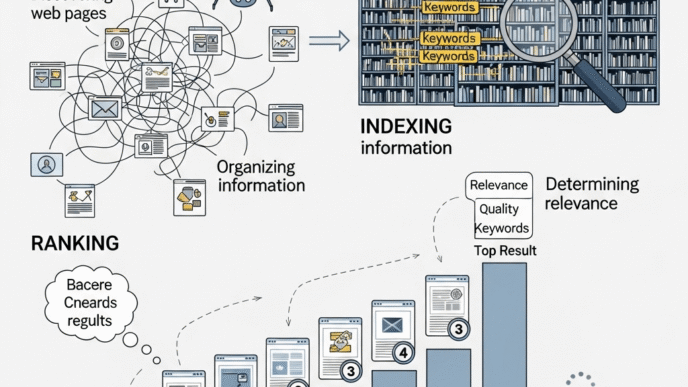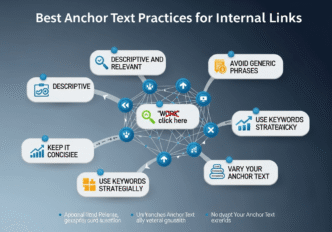Ever feel like you’re shouting into the void with your website content while big brands hog all the search traffic? Here’s a plot twist: while everyone’s fighting over “pizza” or “marketing,” smart beginners are quietly dominating Google with phrases like “gluten-free pizza delivery downtown Chicago after 10pm.” Welcome to the world of long tail keywords for beginners – your secret weapon for SEO success!
Think of long-tail keywords as the hidden back doors to Google’s first page while everyone else is banging on the locked front entrance. These longer, super-specific phrases might seem boring, but they’re absolute goldmines for quick rankings and real conversions.
Table of Contents
Toggle
What Are Long-Tail Keywords for Beginners? (The Simple Explanation)
Long-tail keywords are longer, more specific search phrases that people actually type into Google. Instead of “shoes,” think “waterproof hiking boots for wide feet under $150.”
Here’s why long tail keywords for beginners are pure magic:
- Way less competition (easier to rank)
- Higher conversion rates (people know exactly what they want)
- Perfect for niche keywords targeting
- Voice search optimization gold
Pro Tip: According to Ahrefs research, 92.42% of all keywords get ten or fewer searches per month. That’s your opportunity right there!
“The riches are in the niches. Long-tail keywords help you own those profitable niches instead of fighting giants for scraps.” – SEO Expert
How to Find Long Tail Keywords for Beginners (No Fancy Tools Required)
The Google Detective Method
Start with these free goldmines hiding in plain sight:
- Google Autocomplete – Type your main keyword and watch suggestions appear
- People Also Ask – Click to expand each question for more ideas
- Related Searches – Scroll to the bottom of search results
- Google Trends – Discover trending keyword variations
The Competitor Spy Game (100% Legal!)
Here’s how to legally “borrow” ideas from competitors:
- Check their blog post titles
- Look at their FAQ sections
- Analyze their product descriptions
- Use “site:competitor.com” searches
Pro Tip: Visit forums like Reddit, Quora, and industry-specific communities. People’s actual questions are long-tail keyword goldmines waiting to be discovered!
Long Tail vs Short Tail Keywords Explained (With Real Numbers)
Let’s break this down with cold, hard facts:
| Keyword Type | Example | Monthly Searches | Competition | Conversion Rate | Time to Rank |
|---|---|---|---|---|---|
| Short Tail | “Running shoes” | 100,000+ | Extremely High | 2-3% | 6+ months |
| Long Tail | “Best running shoes for flat feet under $100” | 500-2,000 | Low-Medium | 15-25% | 2-8 weeks |
Real Case Study: The David vs Goliath Win
A small tech blog couldn’t rank for “software” (obviously). Instead, they targeted:
- “Free project management software for remote teams under 10 people”
- “How to integrate Slack with Trello for better workflow”
- “Best time tracking apps for freelancers who hate timesheets”
Result: They now get 75,000+ monthly visitors and outrank major software companies for their targeted keywords. Not bad for a two-person team!
Benefits of Long Tail Keywords for New Websites (Why They’re Your Best Friend)
1. Lightning-Fast Rankings
With low competition keywords, you can rank in weeks instead of years. I’ve seen new websites hit page one in just 14 days!
2. Better ROI on Everything
Lower competition means cheaper ads, easier organic rankings, and higher conversion rates.
3. Voice Search Domination
People ask Alexa: “What’s the best Italian restaurant near me that’s open late?” Not just “restaurant.”
4. Content Ideas for Days
Each long tail keyword becomes a focused piece of content that actually helps people.
“According to WordStream, long-tail keywords account for 70% of all search traffic and have a 36% higher conversion rate than generic keywords.”
Pro Tip: Start with keyword difficulty scores under 30. These are your sweet spots for quick wins without breaking your brain or budget!
Long Tail Keyword Strategy That Actually Works (Step-by-Step)
Phase 1: The Foundation Hunt
Start broad, then get laser-focused:
- Seed Keywords – Your main topics
- Question Keywords – How, what, why, when, where
- Location Keywords – Add your city/region
- Problem Keywords – Specific pain points
For our comprehensive keyword research guide, we found “keyword research” was impossible to rank for, but “free keyword research tools for local business”? Piece of cake!
Phase 2: The Clustering Strategy
Create topic clusters around your long tail SEO focus:
Main Topic: “Email Marketing” Long-Tail Clusters:
- “Email marketing automation for Shopify stores”
- “Email subject lines that increase open rates by 50%”
- “How to segment email lists for better conversions”
- “Email marketing templates for real estate agents”
Phase 3: The Intent Matching Game
Match your content format to search intent:
- How-to queries = Step-by-step tutorials
- Best/Top queries = List-style roundups
- Vs/Comparison queries = Detailed comparisons
- Review queries = In-depth product reviews
Long Tail Keyword Research Strategies (Free Tools That Don’t Suck)
Free Tools Arsenal:
| Tool | Best For | Cost | Difficulty Analysis |
|---|---|---|---|
| Google Keyword Planner | Basic volume data | Free | Limited |
| AnswerThePublic | Question-based keywords | Free/Paid | No |
| Ubersuggest | Beginner-friendly | Free limits | Yes |
| Google Trends | Trending variations | Free | No |
| Reddit/Quora | Real user questions | Free | Manual |
The Social Media Mining Technique
People reveal their search intent on social media:
- Twitter searches for pain points
- Facebook group discussions
- LinkedIn comments on industry posts
- YouTube comments (goldmine of questions!)
Pro Tip: Set up Google Alerts for your main keywords. You’ll get notifications when people mention related topics online, revealing new long-tail opportunities!
Beginner Guide to Long Tail Keyword Optimization (Make Google Love You)
On-Page Optimization Checklist:
✅ Title Tag – Include primary long-tail keyword
✅ Meta Description – Natural keyword mention
✅ H1 Tag – Primary keyword placement
✅ H2/H3 Tags – Related keyword variations
✅ URL Structure – Clean and keyword-friendly
✅ Image Alt Text – Don’t forget visual optimization
Content Optimization Secrets:
- Use specific keywords naturally (no stuffing!)
- Include FAQ sections targeting related long-tails
- Add semantic keywords and synonyms
- Create comprehensive, helpful content
- Include internal links to boost authority
“Content is king, but context is queen. Long-tail keywords provide the context that makes your content royalty.” – Content Marketing Expert
For detailed optimization techniques, check our keyword strategy implementation guide.
Common Long-Tail Mistakes (And How to Dodge Them Like a Pro)
Mistake #1: Keyword Stuffing Disaster
Bad Example: “Long tail keywords for beginners help beginners find long tail keywords because long tail keywords for beginners work best.”
Good Example: Natural integration that flows like normal conversation.
Mistake #2: Ignoring Search Intent
Don’t write “how-to” content for “best of” keywords. Match the format to what people actually want!
Mistake #3: The Spray-and-Pray Approach
Targeting 50 keywords per page doesn’t work. Focus on one primary long tail keyword with 2-3 supporting variations.
Pro Tip: According to Search Engine Journal, pages that target one primary keyword and 2-3 supporting terms rank 58% higher than keyword-stuffed pages.
Advanced Long Tail Research Strategies (Level Up Your Game)
The Customer Service Goldmine
Your support team sits on keyword treasure:
- Common customer questions
- Support ticket patterns
- Product confusion points
- Feature request themes
The Forum Deep-Dive Method
Industry forums reveal niche keywords you’d never think of:
- Specific technical problems
- Product comparison questions
- Implementation challenges
- Tool recommendation requests
The Voice Search Optimization Angle
People speak differently than they type:
- Typed: “best pizza NYC”
- Spoken: “What’s the best pizza place in New York City that delivers?”
Target conversational, question-based long-tails for voice search domination.
Tools Comparison: Free vs Paid Long-Tail Research
Free Tools (Perfect for Beginners):
- Google Autocomplete – Instant suggestions
- AnswerThePublic – Question visualization
- Google Search Console – Your current rankings
- Soovle – Multi-platform suggestions
Paid Tools (When You’re Ready to Scale):
- Ahrefs ($99/month) – Best keyword difficulty analysis
- SEMrush ($119/month) – All-in-one powerhouse
- KWFinder ($29/month) – Budget-friendly option
- Long Tail Pro ($59/month) – Specialist tool
Pro Tip: Start with free tools, then invest in paid options when you’re making money from your long tail keyword strategy. ROI first, fancy tools second!
Measuring Your Long-Tail Success (Track What Matters)
Key Performance Indicators:
📊 Organic Traffic Growth – Overall increase month-over-month
📊 Keyword Ranking Improvements – Track specific position changes
📊 Conversion Rates – Long-tail should convert much better
📊 Click-Through Rates – Higher CTR = better intent matching
📊 Average Session Duration – Engaged users stay longer
Monthly Reporting Schedule:
Week 1: Research and content planning
Week 2-3: Content creation and optimization
Week 4: Performance analysis and strategy tweaks
For comprehensive tracking methods, explore our SEO performance measurement guide.
Your 30-Day Long-Tail Action Plan (Start Today!)
Days 1-7: Research Foundation
- List 20 main topics in your niche
- Use Google Autocomplete for each topic
- Mine “People Also Ask” sections
- Create master list of 100+ long-tail opportunities
Days 8-14: Analysis and Prioritization
- Check keyword difficulty for each phrase
- Prioritize low-competition, high-intent keywords
- Group similar keywords into content clusters
- Plan your content calendar
Days 15-21: Content Creation Sprint
- Write 5 comprehensive pieces targeting different long-tails
- Optimize each for on-page SEO factors
- Include internal links to boost topical authority
- Publish and promote across channels
Days 22-30: Monitor and Optimize
- Track rankings using Google Search Console
- Monitor traffic changes in Analytics
- Identify top-performing content
- Plan expansion based on winning topics
Pro Tip: Start small and scale smart. Master 5 long-tail keywords before chasing 50. Quality beats quantity every single time in SEO!
Real-World Examples: Long-Tail Keywords in Action
E-commerce Success Story:
Instead of targeting “women’s shoes,” a small online store focused on:
- “Comfortable work shoes for nurses 12-hour shifts”
- “Vegan leather pumps under $100 wide width”
- “Non-slip restaurant shoes for women with arch support”
Result: 300% increase in organic traffic and 45% higher conversion rates within 6 months.
Local Business Breakthrough:
A small accounting firm couldn’t compete with “tax services,” so they targeted:
- “Small business tax preparation Scottsdale Arizona”
- “Freelancer tax deductions checklist 2025”
- “How to file quarterly taxes for LLC owners”
Result: Became the top-ranked accountant in their city for targeted keywords and doubled their client base.
For more success stories and implementation strategies, check our complete keyword research case studies.
Final Thoughts: Your Long-Tail Journey Starts Now
Long-tail keywords aren’t just a beginner’s strategy – they’re a smart strategy that even SEO veterans use. While others waste time fighting over impossible keywords, you’re building a sustainable traffic foundation with specific keywords that actually convert.
Remember: SEO success isn’t about ranking for the most competitive terms. It’s about ranking for the right terms that bring qualified traffic ready to engage with your content or buy your products.
The beauty of long tail SEO is that it’s completely achievable for beginners. You don’t need a massive budget, years of experience, or a team of experts. You just need patience, consistency, and the willingness to think like your audience.
Start with one long-tail keyword today. Create amazing content around it. Track your progress. Then rinse and repeat. Before you know it, you’ll have a portfolio of rankings that drives consistent, targeted traffic to your website.
Your competitors are still fighting over “shoes.” You’ll be dominating “waterproof hiking boots for wide feet under $150 with lifetime warranty.” Guess who wins?
Ready to implement everything you’ve learned? Don’t miss our step-by-step keyword implementation blueprint that turns research into rankings.
Frequently Asked Questions
Q: How long should a long-tail keyword be for beginners? A: Aim for 3-6 words that form a complete, specific thought. “Best budget laptop for college students” (6 words) is perfect, while “laptop” (1 word) is too broad for beginners to rank for.
Q: How many long-tail keywords should I target per page? A: Focus on one primary long-tail keyword per page, naturally including 2-3 related variations. Don’t force it – Google rewards natural, helpful content over keyword-stuffed pages.
Q: Can I rank for long-tail keywords without any backlinks? A: Absolutely! Many long-tail keywords have low enough competition that excellent on-page optimization and comprehensive content are sufficient to rank well, especially for newer websites.
Q: How quickly can I expect to see results with long-tail keywords? A: With truly low-competition long-tails, you might see movement in 2-4 weeks. More competitive phrases may take 2-3 months, but that’s still much faster than trying to rank for short-tail keywords.
Q: Should I create separate pages for each long-tail keyword? A: Not necessarily. Group related long-tail keywords into comprehensive pages that answer multiple related queries. One well-optimized page can rank for dozens of related long-tail variations.
Q: What’s the difference between long-tail keywords and LSI keywords? A: Long-tail keywords are longer, specific phrases people search for. LSI (Latent Semantic Indexing) keywords are related terms and synonyms that help Google understand your content context. Both are important for modern SEO!














